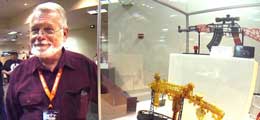Video Transcript
Brian:
Hey. This is Brian from The Cupboard in Cincinnati, Ohio. Today on The Cupboard Presents Artist Insights, we're at The Cupboard to talk with Bob Snodgrass.
Cupboard:
How long have you been blowing glass?
Bob Snodgrass:
Okay. Without doing math, I'm going to go and say my first experience was in 1971.
Cupboard:
You spent a lot of time on tour with The Grateful Dead.
Bob Snodgrass:
Wait a minute. I got to take that back. Mr. Neyfi's lab class, where we made stirring rods for roasting marshmallows, that was my first class.
Cupboard:
You spent a lot of time on tour with the Dead, correct?
Bob Snodgrass:
I bumped into the Grateful Dead, see I was touring, living in a bus with my family doing festivals of all different varieties; hot air balloon shows, mushroom festival, whatever all over the country. It wasn't until '87 that I went to my first Grateful Dead concert. After that, I started going to more Grateful Dead concerts and a lot less other type festivals. People at the hot air balloon shows wondering where I am, I'm here now.
I was making a pipe quite similar to this skull. I called it Mr. Happy. It had red lips and colorful eyes. I'm thinking, every festival I did, I always tried to come up with something to be part of the theme. I was walking across the parking lot in San Diego. "Oh, I got it! I'm going to take Mr. Happy and put teeth on him and leave his eyes clear." That became the top hat.
Cupboard:
Is there anything that you're doing now that you haven't done before?
Bob Snodgrass:
Yeah. We're working out of crucibles. We're actually using a metal blowpipe and making a glass blank maybe three or four inches long and then putting that onto the blowpipe. Picking it up out of the crucible, you dip. You've got to gather. Sometimes, second gather will be this background. We're doing things that are much larger than I was able to do with just a torch.
Awesome place. In fact, I might have come to this store in the early 70's when Chuck Murphy and I were hopscotching all over Ohio and this part of the country.
Oh, it's a spectacular little place. I like the antiqueness. Just, there's so much to look at. It's a great place. Your people are all cool. What a fun place to work, I expect.
Cupboard:
Your collection?
Bob Snodgrass:
Oh, dragon in a tube.
Cupboard:
Dragon in a tube? What's that?
Bob Snodgrass:
It's a pipe inside a tube. When it's smoked right, this thin cylinder of smoke will travel up surrounded by a cylinder of cool air. It fools your lungs and you don't think you've inhaled anything. You're sitting there fantasizing blowing these little smoke rings out of the dragon.
Cupboard:
Sounds cool.
Bob Snodgrass:
It's more than a pipe. It's a toy. I've spent a whole night coming up with one pair of matching eyes. I mix the color for it usually from scratch. I put a lot of special effort into making one of those. Success rate's not anywhere near 100%.
I'm going to be teaching a class at Cornerstone this year. It will be on November. I won't be doing another class until probably after December next year.
Cupboard:
How long do those classes usually run?
Bob Snodgrass:
My typical class is three to five days. I start people out with, if they're a beginner, the first thing they're learning to do is make color from scratch. This blending and making color from scratch lets them acquire a feel and start to understand how the glass is moving. It's not a demand to, "Let's make this." You're learning to understand the media. From there, we expand.
Before Day 3 is up, you've made a skull marble. Maybe your teeth aren't as straight as mine or small as mine, but they end up getting things. I've had people come back and say, "Wow, I took your class seven years ago. Just the other day, something popped out of the blue that I remembered you told me first. It's still coming out of the cracks in the woodwork."
Typically, I show you how to make colors. We use colors for accent or making a marini, but other than that, I don't use much color. I like the transparency, allows me to see the inside wall, the outside wall. I can make nice, uniform pieces. If that's all one solid color and I can't see through it, how do I know I've got the inside working the way it should? I use color- oh, color is also more brittle. They don't bounce near as well as something that's fumed. We tend to always be a little bit clumsy one time or another.





